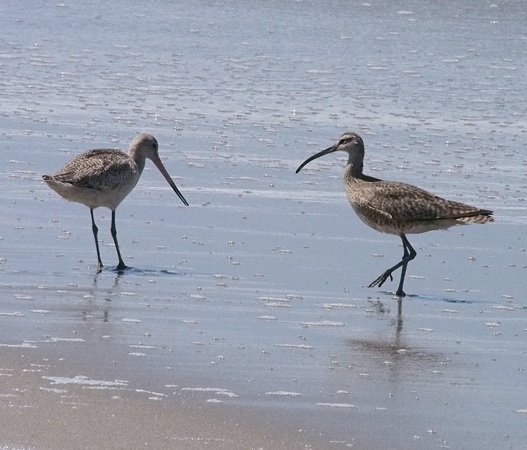A practical guide to bird watching in Sonoma County, California
(Unless otherwise indicated, all phone numbers are in the 707 area code)
A practical guide to bird watching in Sonoma County, California
(Unless otherwise indicated, all phone numbers are in the 707 area code)


Among our largest, regularly seen shorebirds, Whimbrel is found on tidal mudflats, along rocky coastal beaches, and in estuaries. Probably most easily observed in Sonoma County at Bodega Bay. Whimbrel becomes relatively scarce in the county in early summer. Present from around mid-July to mid-May of the following year with numbers greatest during spring and autumn migration (April-May, and August-September). Least common in June. Often solitary, but sometimes in small groups that will fly together in lines. Not uncommonly mixed in with other large shorebirds such as Willet (Tringa semipalmata) and Marbled Godwit (Limosa fedoa).
Distinguished by its large size, long, decurved bill, boldly striped head pattern, and bluish-grey legs. Not likely to be confused with any other bird, except perhaps the related Long-billed Curlew (Numenius americanus), which is larger, more warmly colored (buff or almost cinnamon below and under the wings where Whimbrel is more grey), with an even longer (almost ludicrously long) bill. Whimbrel is not especially common in Sonoma County, but it’s seen here more often than Long-billed Curlew. Marbled Godwit, another vaguely similar (and much more common) bird, is about the same size as Whimbrel, but has a very clearly two-toned bill (Whimbrel may show some reddishness at the base of the bill, but never the distinct red and brown of the Godwit’s bill), which curves up slightly, rather than down. Like Long-billed Curlew, Marbled Godwit generally will appear warmer in tone than Whimbrel, especially when seen in flight with the underwings visible.
Whimbrel can be deceptive. Beginners often find Whimbrel confusing because it can appear to have very different shapes--an illusion. The birds in the pair of comparison photographs below, for example, present rather different appearances. In the photo on the left, the entirety of the legs are visible and the neck is fully outstretched, giving the bird a rather long, fairly elegant look. More often Whimbrel is seen standing in water or sitting (with its legs obscured) and with its neck pulled in, more like the bird in the photo on the right. Sometimes Whimbrel looks even rounder and shorter-necked--like a football with a head pinned on. The coloration (striping) on the head and the long, downwardly-curved bill should always be apparent, however.
Trivia: According to Fix and Bezener, the Latin name Numenious derives from words meaning “new” and “moon.” The curved bill of the Whimbrel and its relatives was thought to evoke a crescent moon.
Further reading:
Bolander and Parmeter, Birds of Sonoma County California, rev. ed., 2000, p. 53
Brinkley, National Wildlife Federation Field Guide to Birds of North America, 2007, p. 220
Dunn and Alderfer, eds., National Geographic Field Guide to the Birds of North America, 5th ed., 2006, p. 170
Dunn and Alderfer, eds., National Geographic Field Guide to the Birds of North America, 6th ed., 2011, pg. 182
Ehrlich, Dobkin, and Wheye, The Birder's Handbook, paperback edition, 1988, p. 122
Dunne, Pete Dunne’s Essential Field Guide Companion, 2006, p. 214-215
Fix and Bezener, Birds of Northern California, 2000, p. 149
Floyd, Smithsonian Field Guide to the Birds of North America, 2008, p. 162
Kaufman, Field Guide to Birds of North America, 2000, p. 188
Kaufman, Field Guide to Advanced Birding, 2011, pp. 210-241 (general notes on shorebird ID), pp. 221
Lukas, Bay Area Birds: From Sonoma County to Monterey Bay, 2012, pp. 104-105
O’Brien, Crossley, and Karlson, The Shorebird Guide, 2006, p. 107-110, 266, 268, 282
Parmeter and Wight, Birds of Sonoma County California, Update (2000-2010), 2012, p. 29
Paulson, Shorebirds of North America: The Photographic Guide, 2005, pp. 157-161
Peterson, Birds of Eastern and Central North America, 5th ed., 2002, p. 142, 144
Peterson, Field Guide to Birds of Western North America, 4th ed., 2010, p. 138
Peterson, Western Birds, 3rd ed., 1990, p. 130
Sibley, Field Guide to Birds of Western North America,1st ed., 2003, p. 156
Stokes, Stokes Field Guide to the Birds of North America, 1st ed., 2010, p. 243
Vuilleumier, American Museum of Natural History, Birds of North America: Western Region, 2011, p. 142
Voice: Cornell Lab of Ornithology: All About Birds--Whimbrel
© Colin Talcroft, 2009, 2010, 2011, 2012, 2013, 2014
Unless noted, all photos by the author. If you would like to use one of my images, please ask for permission for non-commercial use with proper credit or commercial use with proper compensation.
Whimbrel, Bodega bay, August 23, 2011
Legs exposed, neck extended
For comparison: Long-billed Curlew, Moss Landing (Monterey County), July 2, 2012
Note the very long bill and lack of a strong striped look to the head
Whimbrel
Numenius phaeopus
1990-2013 Sonoma County data. Graph provided by eBird (www.ebird.org), generated September 21, 2013
EBird reported occurrence in Sonoma County


Whimbrel, Porto Bodega, October 19, 2013

Whimbrel, Porto Bodega, October 19, 2013
Legs obscured, neck pulled in

Whimbrel in flight, Porto Bodega, October 19, 2013

For comparison: Marbled Godwit, Bodega Bay, April 1, 2010
Note the slightly upturned, clearly two-toned bill. The bill of the Whimbrel turns down.

For comparison: Marbled Godwit left, Whimbrel right. Note the slightly upturned bill of the Godwit,
the clearly downturned bill of the Whimbrel